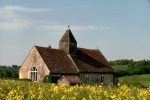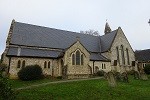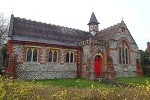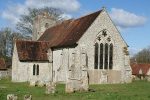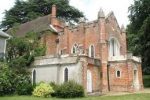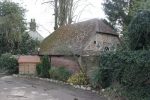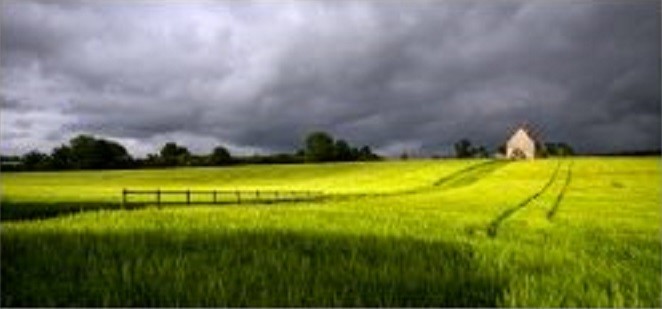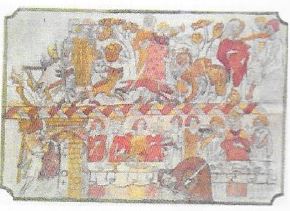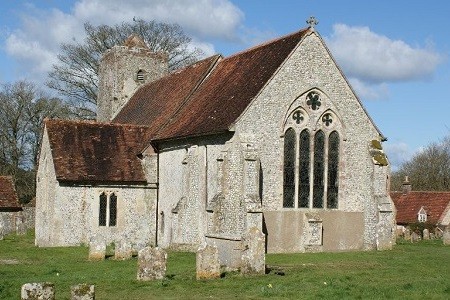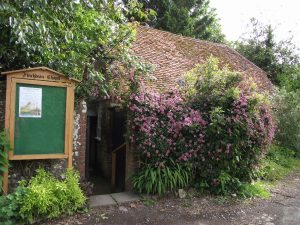Churches
There are six churches and chapels in and around Rowlands Castle, all attractive buildings with interesting histories. Please click on each link to view a brief history of the building and its religious use. There is a link to the website of each place of worship where you can read a more extensive history or find details of current services.
Saint Hubert’s, Idsworth
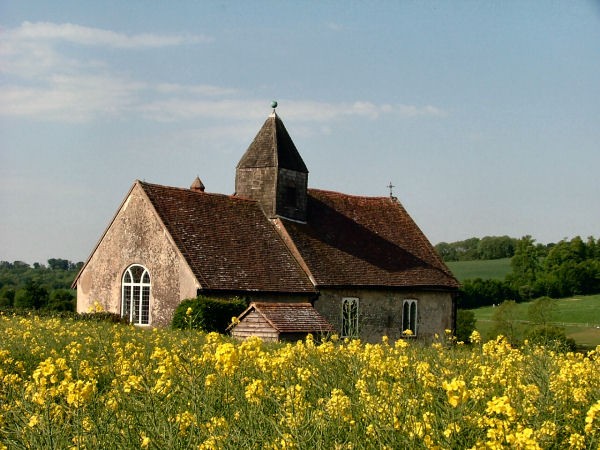
Before 1066 King Harold held the four manors of Chalton (including Idsworth) Stansted, Havant and Warblington. After the Norman Conquest Earl Roger de Montgomery was given their titles, and the bishop of Winchester had the privilege of free chase to hunt and take for his own use animals plants and trees of the forest.
The area was occupied by Saxons both Pagan and Christian, the latter being responsible for St Hubert’s Church at Idsworth. Built in the then “new” Norman style, it was dedicated in 1053 and named the church of St Peter and St Paul, later named St Hubert’s after the Patron Saint of Hunters. Idsworth is not mentioned in the Domesday Book, unlike the neighbouring manor of Chalton, which was held personally by Earl Godwin, premier Earl of England and father of Harold.
It has been suggested that the chapel could have been built on the foundations of a much earlier building, Roman coins and pottery have been found nearby. The sheer simplicity of the chapel draws one in to enjoy a truly holy place. Known locally as the little church in the fields, today countless numbers of folk from far and wide climb the hill to offer prayer and worship to their loving God. Fresh flowers are placed in the chapel by parishioners and many services are held there.
The church might have been visited by grateful parishioners after the Spanish Armada during the reign of Elizabeth 1st. Thanksgiving services would have been held for the ending in victory of the First and Second world wars.
In 1864 ancient murals were discovered on the chapel’s walls and were renovated around the Coronation of Queen Elizabeth II. These paintings have been studied by highly eminent Historians.
This article is taken from the booklet written by Mary Jane Lomer entitled ‘Round and About Rowlands Castle’ 2015, for which she retains the copyright.
The Friends of the Church of St Hubert’s, Idsworth Trust
You may know ‘the Little Church in the Field’ either from the road or the train or perhaps from attending a service or wedding. It has stood there for more than a thousand years but its future now looks most uncertain. In 2016, a Charitable Trust called ‘The Friends of the Church of St Hubert, Idsworth Trust’ was formed to help raise funds to look after the building. More information about the work of The Friends can be found on their website.
More information about Saint Hubert’s including times of services, prayer support, baptisms, weddings, funerals, contact information and its history can be found on the church website.
Saint John’s, Rowlands Castle
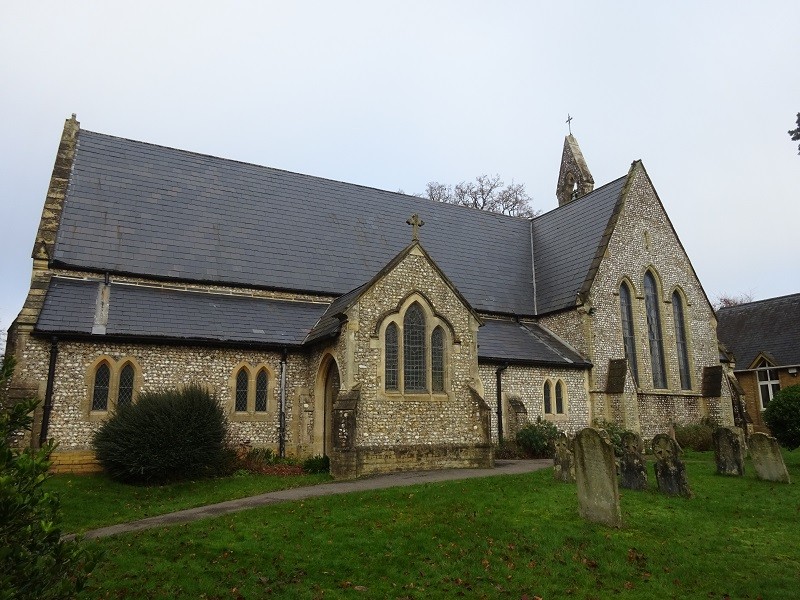
The church fellowship
We are a friendly and supportive church community drawn from inside and outside the village of Rowland’s Castle.
Our aim is to share God’s love with all we meet, and all who come to the Church or Centre. We are fully integrated into all the many and varied activities of village life, and are always open to new people and new ideas.
What we believe
“Our beliefs are rooted in the Bible, uniquely God inspired, the foundation of our faith. We believe in one God, existing in 3 persons, the Father, Son and Holy Spirit, each possessing all the attributes of God. However ‘good’ we try to be, we cannot measure up to God’s perfect standards. But God loves us and wants to be with us. To be restored in relationship with Him, we need to recognise and repent of our sins and receive forgiveness through believing that Jesus alone paid our penalty.
We believe that Jesus was the Son of God, but was born on earth to live a sinless life and show us how to receive salvation. By dying on the cross in our place, He removes the sin from all those who believe in Him as Saviour and ask Him into their lives. We believe He rose from the dead, acts as our mediator with God, and we can enjoy a personal relationship with a living Jesus. Through being washed clean of sin by the shedding of Jesus’ blood, we are born again. The Holy Spirit is the person of God who resides in each born-again Christian. He works in us to develop the fruits of the Spirit – love, joy, peace, patience, kindness, goodness, faithfulness, humility and self-control.
He may endow us with gifts through God’s grace – faith, healing, words of wisdom or knowledge, prophecy, discernment, speaking in tongues, interpretation or miraculous powers. Our salvation through Jesus allows us to live eternally with God. When death comes, it is not the end. We will be resurrected to live for all time with our God.”
More information about Saint John’s including times of services, prayer support, baptisms, weddings, funerals, hiring of the Church Centre, contact information and its history can be found on the church website.
Church on the Green, Rowlands Castle
One of two Churches in the village its life here began over 200 years ago when Christians from the neighbouring towns moved in to bring the Gospel to this rural area. God is still worshipped here today.
What we believe
We believe in the Bible as the true Word of God, in Jesus Christ the Son of God as Saviour of all who believe, and in the Holy Spirit at work in our lives enabling each to have a personal relationship with God and changing us to be more like Jesus each day. We believe in the power of prayer.
Church History
Records say that the Gospel was preached in a cottage standing on Bulls (Bowes) Hill, and that services were conducted by lay preachers from Havant. That was well over two centuries ago and their work was continued by others until, in 1798, a chapel was built and opened, followed 83 years later by a larger chapel opened in 1881 which we now know as the Church on the Green.
The new church built in 1881, was a beautiful building in the Gothic style, of red bricks and native flints, with Bath stone dressings, and its rather good-looking tiled roof was surmounted by an artistic open work spire, inside, the pine timbered ceiling was supported by pine roof trusses designed with an eye to beauty. Church minutes record that from time to time there was anxiety about the safety of the spire, and its removal was considered but, suitably maintained, it still graces the building and together they undoubtedly add beauty to the village green.
Editorial: The above brief history is from Rowlands Castle United Reformed Church A History by Jack Barrett In association with John Hern, 1993
More information about the Church on the Green including times of services, prayer support, contact information and its history can be found on the church website.
Saint Michael and All Angels, Chalton
A footpath runs through the churchyard and many visitors stop at the church and are delighted to find that it is always kept open. The church was built in the late 11th or early 12th century, the design is typical early Norman. The church building is in remarkably good condition and is regularly maintained by volunteers from the church congregation.
More information about Saint Michael and All Angels’ including times of services, prayer support, baptisms, weddings, funerals, contact information and its history can be found on the church website.
Saint Paul’s Chapel, Stansted
On this site was the medieval house that developed from a hunting lodge built by the Fitzalans in the Forest of Arundel. It was ruined in the Civil War, and in 1686-8 a new house was built on the present site by newly-ennobled Richard Lumley, Lord Scarborough, whose grandfather married a Fitzalan heiress. The old hall was described in the 18th century as ‘once the mansion of the Earls of Arundel, now degraded to the stables and barns of a more modern seat’.
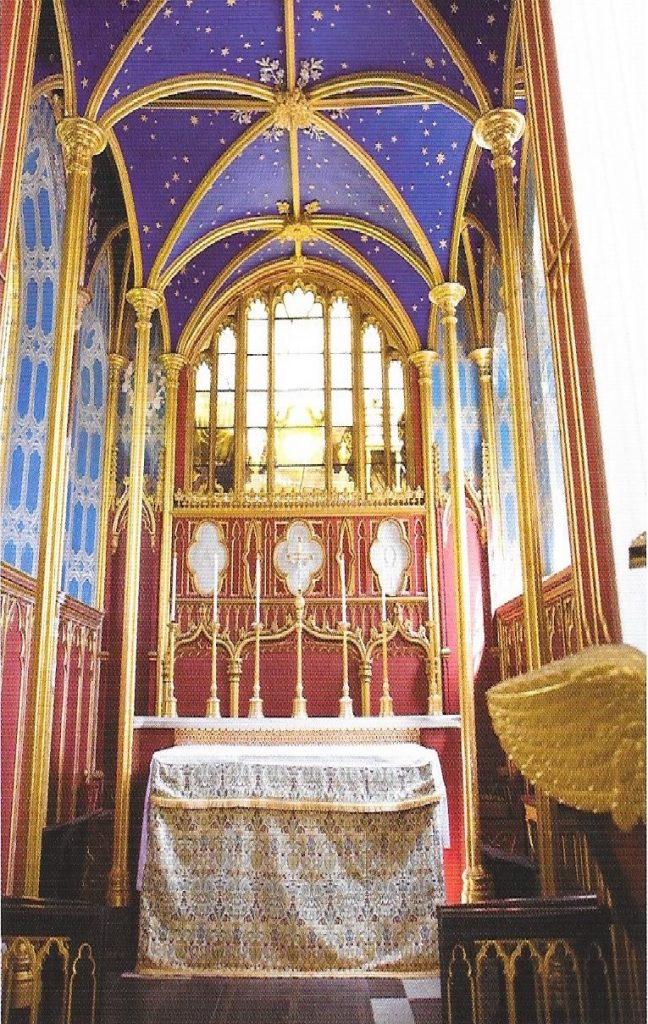
Its west end is 15th century brickwork, although parts of the north wall in flint and stone are earlier. It was converted to a place of worship in neo-gothic style by The Rev. Lewis Way, who purchased Stansted Park in 1804.
Way believed God had told him to reunite the Jewish and Christian faiths and, following an unexpected inheritance he determined to found a mission college at Stansted. The unique, painted east window of the Chapel was commissioned by Way to embody his aspirations, and is believed to be the only window in a Christian church with Jewish symbolism.
When the Chapel was consecrated in early 1819, John Keats, staying nearby at Warblington, attended the service and was inspired to write verse describing the atmosphere and the window in The Eve of St Mark.
In the 1920s the 9th Earl commissioned H.S. Goodhart-Rendel to restore the Chapel and decorate the sanctuary inspired by Sainte Chapelle in Paris, with its gilding and star-studded blue ceiling. After a German aircraft crashed on the cricket ground during the Battle of Britain, blowing out the Chapel windows, it was again restored and new heraldic stained glass arms of the former owners of Stansted were added.
More information about Saint Paul’s including times of services, contact information and its history can be found on the chapel website.
This article is provided courtesy of The Stansted Foundation who retain the copyright.
Finchdean Chapel (Closed)
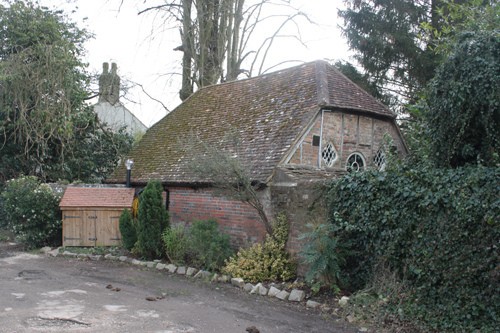
Finchdean Chapel is situated in quite countryside surrounded by fields and woodland, a peaceful haven for sharing in the quietness and tranquillity that is God’s Love
This Small Chapel is very special and ideal for quiet dates and retreat.
A place where you can feel the presence of God’s love surrounding you.
Where you can feel at one with God as the quietness and peace enfolds you.
Come and share the together the quietness and tranquillity that is God’s Love.
